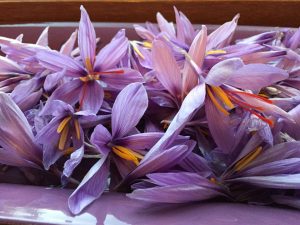
Divine saffron
Emporium Safran Québec is one of the few saffron production companies in Quebec. Saffron comes from the autumn crocus Crocus sativus and is said to be the oldest spice in the world.
The Nordic selection
It brings together 10 varieties which have demonstrated their inestimable value for gardeners in these northern regions!
Take advantage of our selections which include seeds chosen by our team!
Home / Products / seeds / Bulbs, rhizomes and tubers / Saffron Corms – Organic

Emporium Safran Québec is one of the few saffron production companies in Quebec. Saffron comes from the autumn crocus Crocus sativus and is said to be the oldest spice in the world.
Crocus sativus Perennial
29.90$ - 249.90$
Saffron corms (a type of bulb) come from the autumn crocus Crocus sativus, considered the oldest spice in the world. According to recent research, it appeared in Crete rather than in Kashmir as botanists thought for a long time.
The bulbs of Crocus sativus are sizes #10 and up.
* presale From December 2023. Expedition corms are made from the first week of August 2024. Shipping costs are to be expected for this product.
Saffron corms (a type of bulb) come from the autumn crocus Crocus sativus, considered the oldest spice in the world. According to recent research, it appeared in Crete rather than in Kashmir as botanists thought for a long time.
The bulbs of Crocus sativus are sizes #10 and up.
* presale From December 2023. Expedition corms are made from the first week of August 2024. Shipping costs are to be expected for this product.
IMPORTANT: Pre-sale from December 2023 // Shipping from the first week of August 2024. Shipping costs are to be expected for this product.
Contact us by email for orders over 100 corms.
Saffron corms (a type of bulb) come from the autumn crocus Crocus sativus, considered the oldest spice in the world. According to recent research, it appeared in Crete rather than in Kashmir as botanists thought for a long time.
Culture
Like most flower bulbs, saffron requires light, well-drained soil so as not to rot when thaws. It spends the winter very well in Quebec up to zone 3b, with a good snow cover. The planting period runs from August to mid-September. To flower well, the corm must be buried between 20 and 30 cm deep, taking care to place the flattened part from which the roots emerge downwards. Water only in case of drought.
Rendement him
It takes approximately 180 flowers to obtain 1 gram of dry saffron
The first year of planting approximately 60% of the corms will produce a flower.
The following two years the corms will give about 2 flowers each.
The harvest
Flowers bloom 4 to 6 weeks later. Each flower only lasts a few days, so we must check their appearance daily and proceed to harvest without delay, ideally in the morning after the dew has evaporated. Then cut the pistil with its three stigmas using a small scissor or your nails.
Drying
The quality of your saffron depends on this delicate and very important step. The pistils must lose 80% of their moisture during drying, so it is recommended to weigh them before and then during drying to know when they are ready. If you have a small amount of pistils to dry, you can place them in a ventilated, dark place until they are stiff, almost brittle, and blood red in color. Larger quantities can be oven dried at 30 to 50°C (85 to 125°F), 20 to 30 minutes.
Conservation
The best way to preserve all the aroma of your “red gold” is to store it in a glass jar away from light and humidity. Like a good wine, it gains flavor after a maturation period of one month to one year. In good conditions, its flavor lasts for three years.
How to use it in cooking
To exhale all its aromas, saffron must be able to macerate for a long time in a liquid based on water or alcohol which can be hot or cold. The stigmas and the maceration liquid are then incorporated into the preparation at the very end. The ideal maceration time is 24 hours, but if you're short on time, you can speed up the process by crushing the stigmas before steeping them.
We use cookies and other technologies to improve your experience on our site. By agreeing, you allow us to collect data such as your browsing behavior. You can withdraw your consent at any time, but this may affect certain functionality of the site. Your privacy is important to us.
